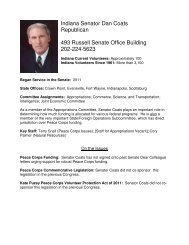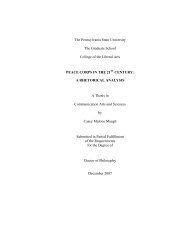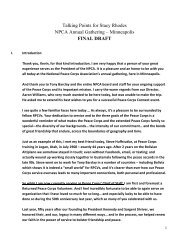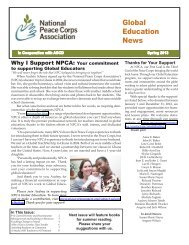Group Education Manual - Peace Corps Wiki
Group Education Manual - Peace Corps Wiki
Group Education Manual - Peace Corps Wiki
Create successful ePaper yourself
Turn your PDF publications into a flip-book with our unique Google optimized e-Paper software.
Handout 11D: Media Campaigns and Social MarketingCampaigns are coordinated sets of activities that aim to promote changes in individual behaviors and/orpromote the socio-cultural and political norms necessary to support these changes. In terms of HIV, theyseek to raise risk perception around HIV and to change social norms and behaviors. Campaigns often includesome form of media and target large numbers of people. There are two key features to successfulcampaigns: 1) they move beyond simple information provision and address underlying norms andperceptions related to behaviors. 2) they are linked to interpersonal activities that allow for individualreflection and skills-building and promote access to services.MEDIA-BASED CAMPAIGNS AND SOCIAL MARKETINGIn the last few decades, there have been rapid developments in communication technologies, multiplying theavailable media channels for reaching audiences, particularly youth (MacDowall and Mitchell 2006). Frombillboards and radio to internet and mobile phones, people are constantly exposed to a large amount ofinformation and messages. These can have a powerful influence (both positive and negative) on social normsabout what it means to be a man and how a man should behave or aspire to behave. To be effective in thiscrowded media environment, it is necessary to package campaigns in ways that can easily catch the attentionof men and other stakeholders, and most importantly, persuade them to adopt and promote healthy andmore-equitable attitudes and behaviors.Traditional public health campaigns have focused solely on “informing” people of unhealthy behaviors andtheir consequences and have often employed dictating or moralizing tones to do so. Experience has shownhowever that these types of campaigns are rarely adequate for effectively engaging audiences and motivatingbehavior change. To this end, public health campaigns are increasingly using principles from commercialmarketing to “sell” healthy behaviors and lifestyles. Social marketing, as this approach is called, entailsmaking specific behaviors and lifestyles more attractive to a given audience through an emphasis on benefitsand advantages.To develop a social marketing campaign, it is important to first understand the underlying socio-culturalnorms which contribute to and support particular behaviors 30 . Much of people’s behavior is influenced bytheir perceptions of what is “normal” or “typical,” that is, what they believe most of their peers do.However, many individuals, including youth, often misperceive the typical behaviors or attitudes of theirpeers. For example, young men may believe that a majority of their peers engage in certain risk behaviors,such as excessive drinking, when in most settings the majority of young men do not. Often, thesemisperceptions are fueled by the media or social norms of what is considered a “real” man. Thesemisperceptions, in turn, may make young men more likely to engage in these behaviors themselves. In thissense, it is important that campaigns address misperceptions or rigid ideas men and others (partners, families,etc.) may have about typical behaviors for men and promote more positive norms around what it means to bea man.Social marketing campaigns can be carried out at local levels through the use of community-based media orat broader levels through the use of mass media. Community-based media, such as street theater, oftenprovides more depth and interaction, whereas, mass media, such as TV dramas produced by commercialstudios with professional actors and technicians, may offer less depth and interaction, but often provideswider reach of messages. The decision to use community-based or mass media or a combination of both willdepend on available resources and the intended audience and depth of contact expected.30 There is a specific form of social marketing known as social norms marketing which is based on applying social marketingtechniques to social norms theory. The central concept of social norms theory is that much of people's behavior is influenced bytheir perceptions of what is "normal" or "typical." To this end, the premise of social norms marketing is that informing people thatthe majority of their peers are acting in a positive or healthy way can create an environment in which people actively strive to emulatewhat they believe is typical of their peers. This approach has proven effective in areas such as preventing tobacco use and drinkingand driving, among other issues. For more information visit the Most of Us website at www.mostofus.org.99
















